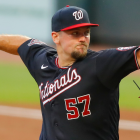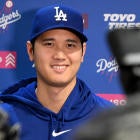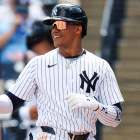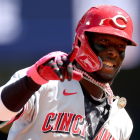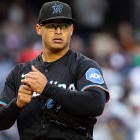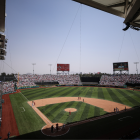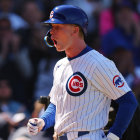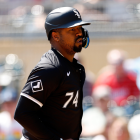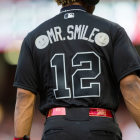
The arrival of the offseason means that it's time to rank stuff. Already this winter, we've sized up the 60 best free agents, both on an overall and positional basis. There's no law that prevents us from ranking minor-league players in addition to their big-league counterparts. As such, we're going to spend the winter evaluating every team's farm system.
The lack of a minor-league season makes that more of a challenge this year. It doesn't help that some teams opted against sharing video and data from their alternate-site camps with the rest of the league. As such, we've opted against overthinking this. Our rankings will essentially be the same as they were last winter with a few changes. First, we'll exclude anyone who graduated by exhausting their rookie eligibility; second, we'll replace them with draftees or other worthy prospects; and third, and lastly, we'll present the information in a new format.
In every article in this series, you'll find a team's top five prospects as well as five others we felt like including, either because of their promise or some other reason. For those top five prospects, you'll find a quick summation of their pros (their saving grace, if one will) and their cons (their fault line), as well as beefier report and our attempt to peg their "likeliest outcome."
These rankings were compiled by talking to industry folks -- scouts, analysts, and other evaluators -- and include a touch of our own evaluative biases. Remember, that this is more of an art than a science, and that the write-ups matter more than the rankings themselves.
Now, let's get on to the top five prospects in the Washington Nationals system.
1. Cade Cavalli, RHP
Age (as of 4/1/2021): 22
Height/Weight: 6-foot-4, 226 pounds
Acquired: No. 22 pick in the 2020 draft (Oklahoma)
Highest level: NCAA
Saving grace: Athleticism
Fault line: Polish
Scouting report: Cavalli is a high-grade athlete who looks the part and who was a two-way player for a time at Oklahoma. He focused on pitching in 2020, and it paid off in the form of improved control. Cavalli still needs to work on mastering his command and a third pitch, but his mid-90s fastball-slider pairing and physicality should allow him to stick in a rotation.
Likeliest outcome: Mid-rotation starter
2. Wil Crowe, RHP
Age (as of 4/1/2021): 26
Height/Weight: 6-foot-2, 228 pounds
Acquired: Second-round pick in the 2017 draft (University of South Carolina)
Highest level: MLB
Saving grace: Big-league ready
Fault line: Upside
Scouting report: Crowe reached the majors last season, making three uninspiring starts over the campaign's final weeks. He should receive an opportunity to amend those missteps in 2021. He has four average or better offerings, including a low-90s fastball (one that didn't miss many bats during his big-league cameo) and a slider that accounted for more than half his pitches.
Likeliest outcome: Back-end starter
3. Mason Denaburg, RHP
Age (as of 4/1/2021): 21
Height/Weight: 6-foot-4, 195 pounds
Acquired: 27th pick in the 2018 draft (Merritt Island High School, Florida)
Highest level: Rookie ball
Saving grace: Upside
Fault line: Injury woes
Scouting report: The Nationals grabbed Denaburg based on the three-pitch promise he showed as an amateur. Unfortunately, he's had limited opportunity to show his stuff as a professional. Between the pandemic and biceps and shoulder issues, he's been limited to 20 regular-season innings since being drafted. The 2021 season is going to be pivotal one.
Likeliest outcome: Anyone's guess
4. Jackson Rutledge, RHP
Age (as of 4/1/2021): 21
Height/Weight: 6-foot-8, 250 pounds
Acquired: 17th pick in the 2019 draft (San Jacinto College)
Highest level: A-ball
Saving grace: Massive upside
Fault line: Command
Scouting report: Rutledge is a big right-hander who went the junior college route after failing to make an impression at Arkansas. He is, predictably, a hard-thrower who has the potential for four average or better pitches, including two swing-and-miss breaking balls. Rutledge will have to work on his command in order to stick in a rotation. It's too early to know if he'll succeed in that endeavor -- it's always a challenge for larger pitchers, and he is nothing if not large. Should he come up short, he should have a promising future as an endgame reliever.
Likeliest outcome: Leading rebounder in his pick-up games; subject of many GIFs; frontline starter, closer, or something in between
5. Cole Henry, RHP
Age (as of 4/1/2021): 21
Height/Weight: 6-foot-4, 211 pounds
Acquired: Second-round pick in the 2020 draft (LSU)
Highest level: NCAA
Saving grace: Stuff
Fault line: Consistency
Scouting report: In terms of upside, Henry should have been selected earlier in the draft than pick No. 55. He has a starter's frame and the ingredients for three average or better pitches, including a power fastball-curveball combination. He was available to the Nationals for a few reasons, beginning with the leverage he had as a draft-eligible sophomore, and extending to his perceived inconsistency. If the Nationals can iron out the latter, they have a chance for a steal.
Likeliest outcome: No. 4 starter
Five others to know
- Eddy Yean, RHP
Yean is a solid bet to crack the top five next year. He's an athletic righty with the makings of a starter's arsenal. He won't turn 20 until June, either, meaning he has ample time for seasoning.
- Drew Mendoza, 1B/3B
Mendoza is a large human being, listed at 6-foot-5 and 230 pounds, who made the expected move from third to first base upon joining the professional ranks. The selling point here is the bat, obviously enough, and he has the potential to make it worth the Nationals' while. Mendoza has big-time raw power and a patient approach. Whether he hits enough to make it all the way to the Show is to be seen.
- Tim Cate, LHP
Cate is a smallish southpaw who atones for a substandard fastball with a good curveball. He throws strikes and could latch on at the back of a rotation.
- Holden Powell, RHP
The Nationals' third-round pick, Powell has a fastball-slider combination that could allow him to move quickly. He's a pure reliever, albeit one who averaged more than an inning per outing at UCLA. While collegiate relievers are notoriously fickle; the Nationals might end up with a setup man.
- Joan Adon, RHP
The Nationals moved Adon into a starting role for the first time in 2019. He was able to mostly hold his own against A-ball competition, accumulating a 3.86 ERA and a 2.05 strikeout-to-walk ratio. Adon will probably fall short of being a legitimate big-league starter because of his command woes, but his three-pitch mix could lead to a career back in relief.













